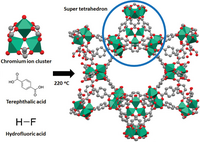Metal-organic framework

Imagine you have a bunch of Legos that you can connect together in different ways. Now imagine you have some very tiny Legos, so small you can't see them with your eyes. These tiny Legos are called atoms, and they can connect together to make all kinds of materials that we see around us - like the chair you're sitting on or the phone you're holding.
A metal-organic framework, or MOF for short, is like a special type of Lego structure that scientists have created using some metals and tiny organic chemicals. It's kind of like a 3D puzzle made out of atoms that repeat over and over again to create a larger structure.
The interesting thing about MOFs is that they have lots of little holes and spaces in between the atoms that make them up. These spaces can be used to trap other tiny things, like gases, liquids, or even other molecules. Scientists are really excited about MOFs because they can be used to store and transport things like hydrogen for fuel or carbon dioxide for environmental purposes.
Think of it like having a bunch of little pockets in a backpack that you can use to carry things around. Except in this case, the MOF is the backpack and the things it's carrying are really, really tiny!
A metal-organic framework, or MOF for short, is like a special type of Lego structure that scientists have created using some metals and tiny organic chemicals. It's kind of like a 3D puzzle made out of atoms that repeat over and over again to create a larger structure.
The interesting thing about MOFs is that they have lots of little holes and spaces in between the atoms that make them up. These spaces can be used to trap other tiny things, like gases, liquids, or even other molecules. Scientists are really excited about MOFs because they can be used to store and transport things like hydrogen for fuel or carbon dioxide for environmental purposes.
Think of it like having a bunch of little pockets in a backpack that you can use to carry things around. Except in this case, the MOF is the backpack and the things it's carrying are really, really tiny!
Related topics others have asked about:
